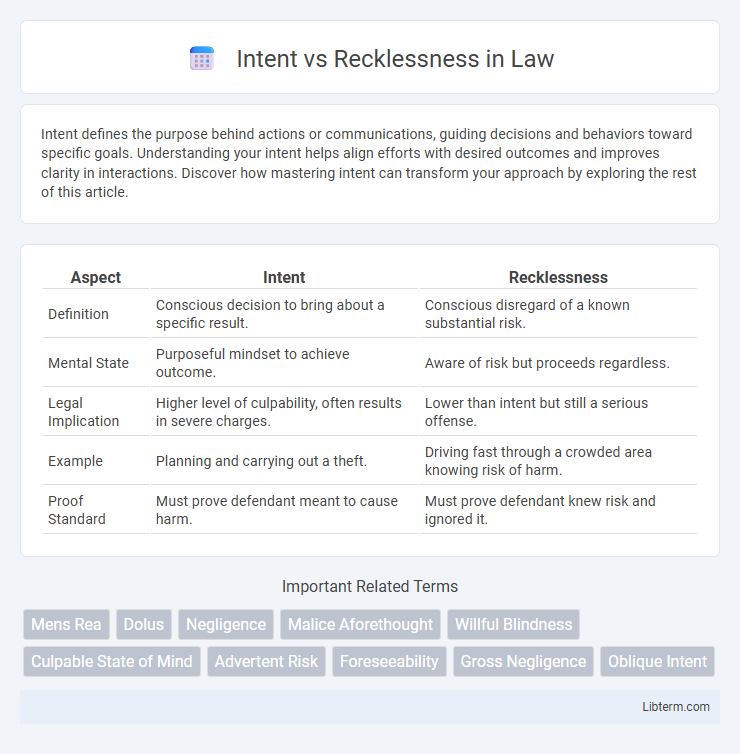Intent defines the purpose behind actions or communications, guiding decisions and behaviors toward specific goals. Understanding your intent helps align efforts with desired outcomes and improves clarity in interactions. Discover how mastering intent can transform your approach by exploring the rest of this article.
Table of Comparison
| Aspect | Intent | Recklessness |
|---|---|---|
| Definition | Conscious decision to bring about a specific result. | Conscious disregard of a known substantial risk. |
| Mental State | Purposeful mindset to achieve outcome. | Aware of risk but proceeds regardless. |
| Legal Implication | Higher level of culpability, often results in severe charges. | Lower than intent but still a serious offense. |
| Example | Planning and carrying out a theft. | Driving fast through a crowded area knowing risk of harm. |
| Proof Standard | Must prove defendant meant to cause harm. | Must prove defendant knew risk and ignored it. |
Understanding Intent: A Legal Perspective
Understanding intent in a legal perspective involves recognizing the defendant's conscious objective to engage in specific conduct or cause a particular result, which is crucial in distinguishing intentional acts from reckless behavior. Courts evaluate intent by examining subjective awareness and purpose, requiring evidence that the individual acted with purposeful desire or knowledge that their actions would lead to a prohibited outcome. This focus on mental state differentiates intentional crimes, which demand proof of deliberate action, from reckless offenses characterized by conscious disregard of substantial risks.
Defining Recklessness in Law and Ethics
Recklessness in law and ethics is characterized by a conscious disregard of a substantial and unjustifiable risk that a particular consequence will result from one's actions. It differs from intent, which involves a purposeful aim or desire to bring about a specific outcome, whereas recklessness requires awareness of risk but proceeds without concern for potential harm. Legal definitions often emphasize the subjective awareness of danger, making recklessness a key element in distinguishing culpable conduct from mere negligence.
Key Differences Between Intent and Recklessness
Intent involves a conscious decision to bring about a specific outcome, whereas recklessness refers to a disregard of a substantial and unjustifiable risk without the purpose of causing that result. Intent requires purposeful action targeting a particular consequence, while recklessness is characterized by awareness of danger but indifference to the potential harm. The key difference lies in the mindset: intent is deliberate and goal-oriented, recklessness is marked by careless disregard.
Historical Evolution of Intent and Recklessness
The historical evolution of intent and recklessness traces back to early common law distinctions where intent referred to a purposeful action to cause harm, while recklessness described a conscious disregard of substantial risks. Over time, legal systems refined these concepts, emphasizing mens rea elements to differentiate degrees of culpability and assign appropriate penalties. Modern jurisprudence continues to develop nuanced standards, integrating philosophical and psychological insights to accurately assess an individual's mental state at the time of the offense.
Elements Required to Prove Intent
Proving intent requires demonstrating the defendant's conscious objective to engage in a specific act or achieve a particular result, often established through direct evidence, circumstantial evidence, or explicit statements. The prosecution must show the defendant's knowledge and purpose in committing the act, highlighting awareness of consequences and deliberate decision-making. Unlike recklessness, which involves conscious disregard of risk, intent necessitates proof of purposeful action aimed at the forbidden outcome.
Assessing Recklessness: Criteria and Examples
Recklessness is assessed by evaluating whether an individual consciously disregards a substantial and unjustifiable risk, demonstrating a gross deviation from standard conduct. Key criteria include awareness of the risk, subjective appreciation of the danger, and the unreasonable nature of the risk taken. For example, driving at high speed through a crowded pedestrian area despite knowing the potential harm evidences recklessness.
Legal Consequences: Intentional Acts vs Reckless Behavior
Intentional acts involve a deliberate decision to commit a specific act, often resulting in more severe legal consequences such as higher fines, longer prison sentences, or enhanced penalties under criminal law. Reckless behavior, defined by conscious disregard of a substantial risk, typically leads to lesser charges like criminal negligence or manslaughter but still carries significant legal repercussions. Courts assess the defendant's state of mind to differentiate intent from recklessness, influencing sentencing, liability, and the overall outcome of the case.
Case Studies Illustrating Intent vs Recklessness
In the landmark case of R v Cunningham (1957), recklessness was defined as the conscious disregard of a substantial risk, highlighting the defendant's awareness yet indifference to potential harm. Contrastingly, R v Woollin (1998) established that intent requires a virtual certainty of consequence, with the defendant foreseeing the outcome as a direct goal. These case studies underscore the critical legal distinction: recklessness involves risk awareness without desire for harm, while intent denotes purposeful action towards that harm.
Impact on Sentencing and Liability
Intent significantly increases sentencing severity and criminal liability as it demonstrates a deliberate decision to commit a wrongful act, often leading to harsher penalties such as longer prison terms or higher fines. Recklessness, reflecting a conscious disregard of a substantial risk rather than a purposeful aim, typically results in moderate sentencing and liability, acknowledging culpability but with less moral blame than intent. Courts weigh the degree of intent against recklessness to determine proportional punishment, emphasizing the defendant's mental state to assess both criminal responsibility and sentencing outcomes.
Preventing Misinterpretation: Practical Implications
Clear distinctions between intent and recklessness are essential to prevent misinterpretation in legal contexts, affecting charges and sentencing outcomes. Intent involves a conscious decision to bring about a specific result, while recklessness denotes a disregard for substantial risk without a purposeful aim. Accurate assessment of these mental states ensures fair legal judgments and effective application of criminal law standards.
Intent Infographic

 libterm.com
libterm.com